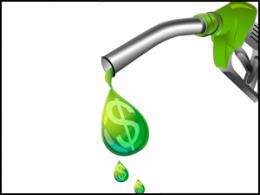(Phys.org) -- One of the hallmarks of the human race has been the myriad ways that single individuals or small groups respond when noting problems big and small. They may see something as a challenge or a glitch in the status quo, or simply as a way to improve on what currently exists using their intellect, their time and of course their energy, and because of that, things improve for everyone else. In just that vein comes a new kind of nozzle or nozzle attachment that solves the problem of dripping after the flow of a liquid has been stopped. We see it with our various types of water taps, but more often when transferring fuel from one container to another, especially when filling the gas tank of our cars and trucks.
The problem generally occurs because of the way we transfer our liquids such as gasoline. Rather than simply pour it, we prefer the convenience of a pump, hose and nozzle. This arrangement makes it easier to get the gas into our tank and to measure how much has been transferred. Unfortunately, it also leads to a tiny bit of leftover when the pump is turned off, which in most cases winds up as little drops of gasoline falling to the ground just before nestling the nozzle back into its holster. And that Canadian company Dram Innovations says, leads to some 500 million liters of gasoline dripped onto the ground and evaporated into the atmosphere worldwide every year.
To solve the problem, the company has developed a nozzle technology that can be used to prevent drips of any type, but that focuses most particularly on gasoline dripping. They’re not saying of course, exactly how it works, but one part of it at least employs the use of a small screen similar to that used to disperse the flow of water from a faucet. They say their nozzle, which can be attached directly to the end of a hose to replace conventional nozzles, or added as an attachment could serve as both a convenience and a means of reducing pollution.
The convenience factor comes in as consumers would no longer have to worry about drops falling on their hands, shoes, pant legs, etc. The pollution factor comes in due to the fact that when gasoline falls to the ground, it reacts with the surrounding air and produces ozone, and we all know what that does.
The company hasn’t yet found a buyer for their nozzle but hope to attract the attention of consumers and then hopefully big oil companies who they say would benefit too, as lost drops impact the bottom line of gas station owners as well.
© 2012 Phys.Org


.jpg)



















